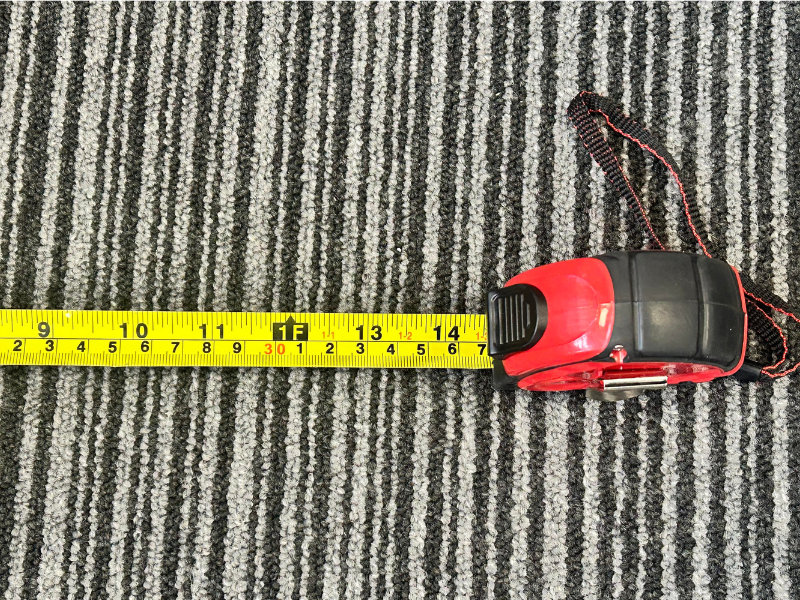Before any new flooring can be fitted — whether it’s laminate, carpet, or LVT (luxury vinyl tile) — an accurate floor measurement is essential. It ensures the right amount of material is ordered, the subfloor is properly prepared, and there are no surprises once installation begins.
But there’s more to measuring than just grabbing a tape and jotting down a few numbers. A good floor measurement considers the structure beneath your existing flooring, potential obstacles, moisture levels, and even the layout of the room.
Here’s an in-depth guide on what to check and prepare before a professional floor measuring appointment.
1. Understand What’s Under Your Current Floor
The most important thing to know before a new floor is installed is what type of subfloor you’re dealing with. The subfloor determines how the new surface — whether it’s laminate, carpet, or LVT — will be laid and what kind of preparation might be needed.
If it sounds hollow:
You likely have a timber subfloor, made from plywood or chipboard sheets fitted over wooden joists.
- Common in upper floors or older homes.
- Can flex slightly or produce a hollow sound when walked on.
- Joists may have gaps underneath, meaning insulation or underlay choices can make a big difference to soundproofing and warmth.
Before measuring, check for any loose boards or squeaks — these can signal movement that should be fixed before new flooring is laid.
If it sounds solid:
You’re probably standing on a concrete subfloor, typical in ground-floor rooms, extensions, or newer properties.
- Feels solid underfoot with a dull, non-hollow sound.
- Often requires a moisture test before fitting laminate or LVT, since concrete can release residual damp even years after curing.
- Small cracks or uneven areas may need smoothing or a self-levelling compound before installation.
Knowing which type you have helps the fitter plan the correct underlay, adhesive, or preparation method.
2. Watch Out for Pipes, Cables, and Heating
Many modern homes have central heating pipes, underfloor heating, or electrical cables running just below the surface. These can all affect how your new flooring is installed.
- Underfloor heating systems need specific compatible products — for example, not all laminate or LVT types are designed to handle heat expansion.
- Water pipes or radiator lines can limit where you can nail, screw, or trim flooring.
- Electrical cables should always be identified before drilling thresholds or fixing grippers for carpet.
If you’re unsure what’s under your floor, mention it before measuring. A flooring professional can use a detector to scan for hidden services, which prevents costly mistakes later.
3. Check for Damp, Damage, or Uneven Areas
One of the biggest causes of flooring problems is moisture or unevenness in the subfloor. Even the best laminate, carpet, or LVT won’t perform well if the base beneath it isn’t sound.
Signs to look for before measuring:
- Dark or discoloured patches on skirting or floor edges (possible damp).
- Soft or swollen areas in timber floors (suggests moisture or rot).
- Uneven tiles or cracked concrete (might need levelling compound).
If you notice any of these, it’s worth noting them before a measurement so they can be factored into preparation. Damp proof membranes (for concrete) or plywood overlays (for timber) may be recommended before fitting.
4. Clear Access and Furniture
To get the most accurate measurement, it’s best to have as much of the floor visible as possible.
- Move smaller furniture and clear corners if you can.
- Point out any areas you can’t access — for example, built-in wardrobes or appliances — so the measurer can account for them properly.
- If heavy furniture can’t be moved, let the fitter know. They may include allowances or note that area as a fixed space.
Full visibility means the measurement will reflect the true shape of the room, including recesses, doorways, and alcoves.
5. Consider Door Clearances and Thresholds
Many people overlook door height until after the flooring is fitted. Different products add different thicknesses:
- Carpet tends to be thicker, especially with underlay.
- Laminate and LVT are thinner, but still may raise floor levels slightly.
If doors currently catch or drag, mention it during the measuring stage. The fitter can check whether doors will need trimming or whether a transition strip is required between rooms with different floor heights.
6. Identify Floor Levels and Adjoining Rooms
Flooring doesn’t exist in isolation — how it connects to other rooms matters.
- If one room has carpet and another will have LVT or laminate, note the difference in height.
- Transitions between materials may require trims, ramps, or threshold strips.
- For open-plan spaces, consistent levels are key for both appearance and safety.
Highlighting these details before measuring helps avoid awkward edges or unexpected steps later.
7. Plan for Timing and Room Conditions
It’s also worth considering the environment when planning new flooring.
- Rooms should be dry, warm, and ventilated during measurement and installation.
- For laminate and LVT, temperature and humidity matter — materials need to acclimatise to the room for at least 24–48 hours before fitting.
- If you’re decorating or doing other renovation work, flooring should usually come last to avoid paint splashes or dust damage.
8. Take Notes and Ask Questions
The measuring visit is the best time to ask technical questions about the process, especially if you’re choosing between carpet, laminate, or LVT. Ask about:
- Suitable underlays or adhesives for your subfloor type.
- Moisture protection and soundproofing options.
- Maintenance requirements for each flooring type.
The more you know beforehand, the easier it is to plan and budget accurately.
Final Thoughts
A proper floor measurement isn’t just about square footage — it’s about understanding the surface beneath, identifying potential challenges, and ensuring your home is ready for installation.
Before anyone comes to measure, take a few minutes to check what’s under your existing floor, note any uneven areas, and clear the space for easy access. Whether you’re fitting carpet, laminate, or LVT, the preparation you do beforehand makes a huge difference in achieving a smooth, long-lasting finish.



